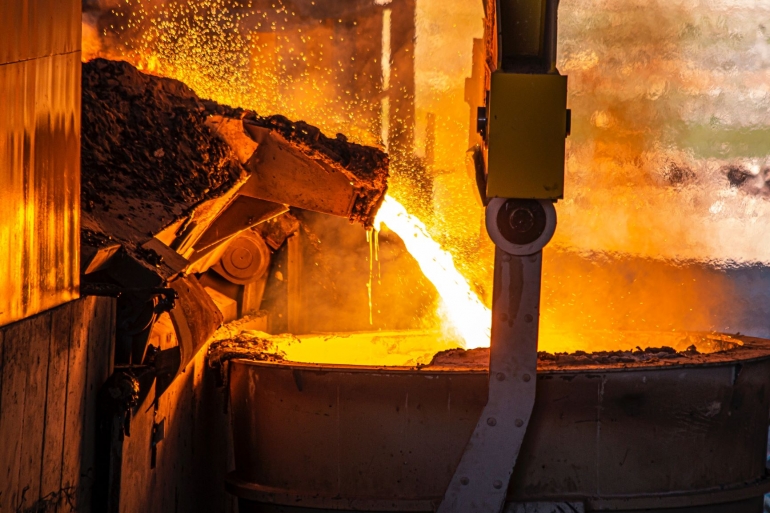Latest news
Read the latest news from the Centre for Sustainable Materials Research and Technology

This feature article highlights various global innovations to help the world move to more sustainable steel manufacturing, including the ongoing work by the UNSW SMaRT Centre with its patented Green SteelTM invention.
"The inside story on green steel", by publisher The Fifth Estate,
By Poppy Johnston
In response to rising demand for greener steel, the local steel-making industry is hurrying to clean up its products. The major players are taking steps in the right direction, with big announcements from the likes of Andrew “Twiggy” Forrest and Sanjeev Gupta attracting attention.
Trouble is, on emissions reduction, the steel supply chain faces an expensive, technically challenging low carbon transition and a tight deadline. Steel manufacturing is responsible for around 7 per cent of global emissions and like concrete, its emissions intensity is not just from energy use but also a chemical process in its manufacture.
Low emissions steel technologies have been invented but scaling them from the lab to commercial viability will be extremely expensive. Government funding will likely play a role in the risky early stages, some say, with the transitioning industry a prime candidate for the next wave of green finance.
A benefit of steel is it is highly recyclable. It’s already the most recycled material on the planet by weight and, given its durability, has long lifespans between each recycle.
The material is also already on the journey towards a completely closed loop lifecycle. Professor Veena Sahajwalla’s Centre for Sustainable Materials Research & Technology (SMaRT) at University of New South Wales has invented a technology that uses old rubber tyres, which contain carbon and other useful materials for steelmaking, as a replacement for coke and coal in an electric arc furnace (EAF). The Polymer Injection Technology (PIT), or Green SteelTM, sees recycled polymers from tyres used as alternate carbon injectants to produce the foaming slag that acts as a blanket over the molten steel during the steelmaking process.

The PIT process reduces reliance on non-renewable materials, and finds a solution for the growing problem of waste rubber tyres, with the ultimate aim of eliminating the need for coal and coke in EAF steel production entirely. It also improves the performance of the slag and the energy efficiency of the EAF steel making process. She says that most resource recovery, depending on the material being recycled, presents an opportunity to reduce the overall carbon footprint of manufacturing because it makes use of the embodied energy in the existing product.
Sahajwalla says that the PIT technology, which is easily retrofittable and inexpensive because it doesn’t involve the complete replacement of existing steelmaking kit, is a sensible starting point to reduce emissions and raw resource consumption in steel manufacturing.
The technology is illustrative of Sahajwalla’s broader resource recovery philosophy that seeks to break down complex and problematic “waste” items – mostly not subject to any recycling – into their raw molecular structure to be reformed into new items, without product sacrificing quality or performance.
Sahajwalla’s confident that there’s enough scrap and waste material available to close the loop entirely on steelmaking. While the focus is currently on large volumes of scrap steel, such as old cars and demolished buildings, she says there’s “more than enough good quality metal in our homes that can be harnessed.”
Anne-Claire Howard, the chief executive officer of ResponsibleSteel, a global organisation that sets sustainable steel standards and certifications, also says there’s no reason steel couldn’t “ultimately be a fully circular product”.
She says that while there’s currently a global shortage of scrap steel, steel production is expected to peak around 2050, according to some estimates.
Michael Parker is Australasia president at MolyCop, a Newcastle-based steel manufacturer that is teaming up with the UNSW SMaRT Centre researchers to roll the technology out across its global operations.
Parker says that MolyCop is able to offer steel products with a quarter of the emissions of traditional integrated steel makers because it only makes steel in an electric arc furnace and has a renewable power purchase agreement, which covers more than half of its electricity consumption in NSW.
Reducing raw resource use is also a priority for the company. Sahajwalla’s PIT technology, once installed, will help the company kick its reliance on imported alloys and carbon that goes into the EAF and consume up to 75,000 waste tyres a year. The company also remelts the steel cord from these tyres and recycles it.
Parker says the company saw an opportunity to grow its presence in the circular economy and decided to acquire family-owned waste management business JLW Services that specialises in problematic waste streams, including old tyres and mattresses. The company plans to keep expanding the use of waste in its steel manufacturing, and is currently working with Sahajwalla’s team on a new pilot project that involves extracting iron from printer cartridges.